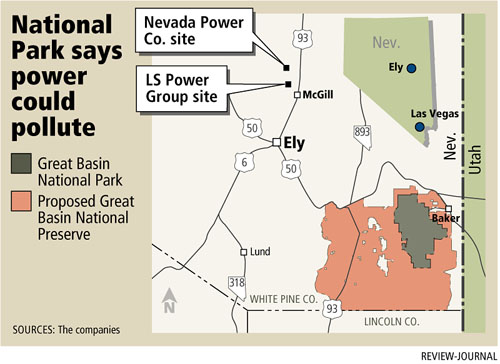Park Service opposes LS Power project

An independent power producer is meeting opposition from the National Park Service about potential air pollution from a planned coal-fired power plant, but a spokesman for Nevada’s electric utilities expects no problem with their similar project.
The park service has sent stinging comments in response to an Environmental Impact Statement that was filed for the White Pine Energy Station that LS Power Group is planning to build. The 1,590-megawatt pulverized coal power plant would be built near Ely, about 60 miles northwest of Great Basin National Park.
Nevada Power Co. of Las Vegas and Sierra Pacific Power Co. of Reno also are developing a 1,500-megawatt, pulverized coal plant that will be even closer to the park.
Although Mark Severts, a spokesman for the Ely Energy Center, said the utilities don’t foresee park service opposition, an official said he isn’t so sure the power plant will be acceptable to the federal agency.
“If you have another coal-fired power plant similar in size to the White Pine power plant, we would have similar concerns,” said John Bunyak, a park service manager.
Bunyak declined to define what position the park service will take on the Ely Energy Center before studying the utility’s power plant proposal.
The key difference between LS Power’s project and the utilities’ is the independent power producer’s plan to use dry scrubbers, rather than wet scrubbers, to reduce sulfur dioxide pollution.
The park service favors wet scrubbers, but Eric Crawford, project development director for LS Power, said the advantages of dry scrubbers outweigh the benefits of wet scrubbers.
Wet scrubbers use more water than dry scrubbers, cause a visible plume from the smokestack, are less efficient and lead to higher amounts of other kinds of pollution, Crawford said.
Severts said wet scrubbers would reduce the sulfur dioxide from the utilities’ project to 0.06 pounds per million British Thermal Units, compared with 0.09 pounds for LS Power. (A BTU is the amount of energy needed to raise the temperature of one pound of water by one degree Fahrenheit.)
Crawford said its project would emit between 0.065 pounds per million BTUs and 0.9 pounds per million BTUs, depending on the sulfur content of coal.
The numbers apparently don’t satisfy the park service.
If LS Power “chooses to locate near the national park, it should assume the burden of protecting the resources in that park from the effects of its operation,” the federal agency said in written comments.
If LS Power is not agreeable to “going the extra mile,” then “it should consider an alternate location,” the park service said.
Air pollution from the plant would reduce visibility, the park service claimed. Sulfur and nitrogen pollution from the plant could deteriorate the habitat of cutthroat trout, particularly at Baker Lake. Nitrogen could promote invasive plants to the detriment of native plants, make range fires likelier and cause trees to die, the park service claimed.
The park service favored development of a coal gasification plant, which would be 10 percent to 20 percent more expensive, but would reduce pollution.
Technology for converting coal into a gas for burning at power plants is not commercially, readily available, Crawford said.
“We need a reliable and economical project,” he said. “We’re committed to make this project fit well with the community and the environment, and we believe we’re doing that.”
LS Power will have more leeway for pollution at Great Basin than it would at some older national parks.
Great Basin is categorized as a Class 2 area because it was designated a national park in 1986, after 1977 provisions in the Clean Air Act made Class 1 the standard for then existing national parks.
With the LS Power project, Class 1 standards would be maintained for “prevention of significant deterioration” for Great Basin, Crawford said. It may not satisfy federal guidelines on visibility and the amount of pollution that lands in the park, he said.
The park service “cannot legally treat it as a Class 1 area,” said Jeff Holmstead, who served as chief of air pollution regulation at the Environmental Protection Agency between 2000 and 2005. Holmstead now works in Washington, D.C., as a partner at the law firm Bracewell & Guiliani and heads the firm’s environmental strategy group.
Holmstead said he didn’t know of any discussions in Congress about giving new national parks the higher Class 1 air quality standards.
Meanwhile, Crawford hopes to complete the regulatory process so that it can begin building the power plant next year, but that depends on financing and finding buyers for the power produced.
Also, an environmental group may challenge the project’s approval to the Environment Protection Agency’s Environmental Appeals Board. That could delay the project, too.
“It’s happening all across the country (with coal-fired power plants),” Crawford said.












